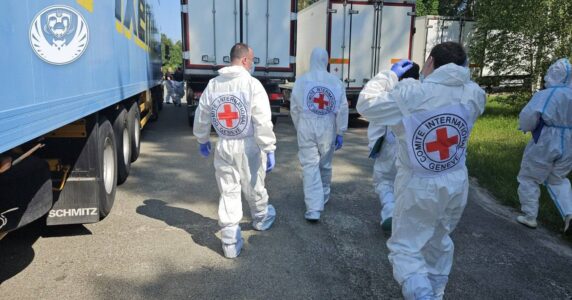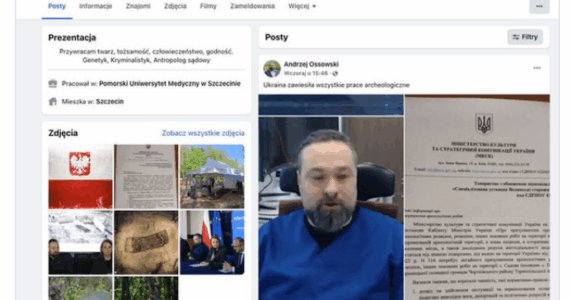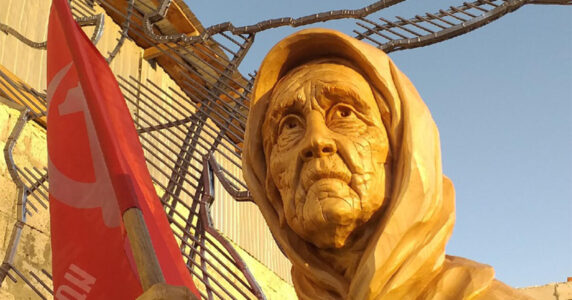Navigation and useful materials
Moscow is figuring out who is to blame for the open sky over the headquarters of the Black Sea Fleet, while the occupiers in Ukraine are doing over the “heroism” showed by their grandparents in 1941. The Centre for Strategic Communication and Information Security has collected the main fakes and narratives of the Russian propaganda of July 29-31.
- Paper knife vs. Ukrainians’ morals
- Two months of preparation for Olenivka was not enough for the Russians
- Sevastopol UAV raid: what the FSB and the Russian MoD will agree on
- Putin is preparing oligarchs’ yachts for war
The end of the week seemed quite tough for Russian propagandists. First, they needed to deflect the information blow from the published video showing torture of a Ukrainian serviceman. Then they needed to deliver their own information blow against the barracks in Olenivka housing our PoWs. And finally, they had to answer for the ruined Navy Day celebration in the occupied Sevastopol. And they failed at all three. Nothing really went right for them.
Paper knife vs. Ukrainians’ morals
A video was published on social media in which a Russian soldier tortures a Ukrainian prisoner of war with a paper knife. Later, military journalist Andrii Tsaplienko reported that the tortured man had been shot and released footage of the body being dragged with ropes.
Russian channels immediately started spreading information that it was an information operation by the SBU. The goal was allegedly to “increase the level of hatred for Russia in the situation when the West accepted several compromises with it.” A strange man calling himself a political scientist claimed that there was no hatred towards Ukraine in Russia.
IN REALITY, it is unclear what compromises this is all about. Another thing is clear, though.
First, this video is an attempt to make Ukrainians more emotional and provoke them into similar actions against Russian prisoners, to be used for further stories of the Russian propaganda about the “Ukrainian Nazism.”
Second, Moscow is trying its hardest to intimidate its soldiers into never surrendering. They are being told that they will become targets to avenge the man in the video. Putin’s people already used a similar “preventive practice” in their punitive operations in Chechnya.
Third, this video once again proves that the occupiers have nothing humane, or human, about them.
Torture in the Ukrainian war is the result of the social order in Russia with its fear and hatred of everything foreign, cultivated by mass culture values of the gangster and prison world and Chekist “valour.”
For years, the Kremlin propaganda has been systematically dehumanizing Ukrainians, depicting them as morally and intellectually inferior, as traitors and pests for Russia. The most similar historic analogies are the cult of racial superiority in the Nazi Germany and pitting Hutu against Tutsi in Rwanda.
Putin, like Hitler once, freed his soldiers from the “confusion of conscience”. Therefore, murderers, torturers, rapists and looters find it hard to even realize they are committing war crimes (or even just crimes) in a foreign country. They film videos of these “achievements” and boast of them on social media and to their families.
And only the doublethink, described by Orwell and well-developed since the Soviet times, makes Russians vehemently deny these crimes with no sincerity and shift the blame to the other side. Which is what we observe in the specific case with the torture of a PoW.
Russia brings not only death and destruction to Ukraine, but also its own perverted morality. It’s as if they are inviting Ukrainians to respond in a similar fashion, to take revenge, both showing off and denying atrocities. The Kremlin knows that when we have moral perverts fighting on both sides, nobody will sympathize with either, regardless who started this.
That is why we must protect not only our land and people, but also our own consciousness, conscience and principles from aggression. No matter what happens, we cannot follow in our enemies’ footsteps. We cannot win the war with a paper knife. We can only win by believing in our cause, with the help of international solidarity, and, of course, with the best weapons in the world.
Two months of preparation for Olenivka was not enough for the Russians
Violations of international humanitarian law against one Ukrainian prisoner are easily scaled for dozens and hundreds of prisoners. This was proven by the crime in Olenivka, which came to light on the very same day.
The joy over the murder among Russians is mixed with attempts to shift the blame. The Russian propaganda hastily announced that “Ukrainian Nazis shot their own Nazi prisoners using the American HIMARS.” At the same time, another version was launched — “it was not the Ukrainians, but the Americans themselves who shot the Azov soldiers.”
IN REALITY, Olenivka is right next to Mariinka, where the front line is currently located. Using the long-range and scarce HIMARS systems (which can be easily verified, too) for such short distances makes no sense at all.
It would seem that the Russians came up with the accusations about the Ukrainian and NATO traces hastily and carelessly. A whole lot of questions (largely rhetorical, of course) only shows the inadequacy of the propaganda support to this whole operation:
Why waste missiles costing USD 160,000 each?
Why didn’t Russians come up with at least a couple of hurt employees of the colony to cover up their tracks?
Why not come up with more destruction on site to show how HIMARS is inaccurate, and Americans are merciless?
Why were representatives of the International Committee of the Red Cross not allowed into the colony as of August 1? Just a few hours after the tragedy, the Russian MoD claimed that it “officially invited experts to carry out an objective investigation.”
Why did this “shelling” of the colony, which took quite a lot of funds to equip, strangely coincide with the arrest of deputy commander of the Southern Military District of Russia Voronov the day before? The colony is located in the territory assigned to him, and according to the investigation, he spent about 2 million budget roubles setting up his house and land.
Why did the execution in Olenivka take place after the sentence of the occupier Shyshymarin sentenced to life imprisonment in Ukraine was reduced to 15 years, which probably indicated his further exchange?
Why did the tragedy in Olenivka happen the next day after the Ukrainian Parliament decided that exchanged PoWs would not face punishment?
There are many questions. Stopfake described step by step how Russian propaganda prepared for the shelling in Olenivka for at least two months. Evidently, it was not enough.
The Russians cannot hide their premeditated and cold-blooded murder. The reasons can be different, from corruption to media considerations, just so long as they could satisfy the bloodthirsty public, disappointed with events like the exchange of Taira and the first Azov soldiers.
READ ALSO: Operation Taira as Russia’s Information Failure
And let’s say a few words about killing inmates in prisons. The historical predecessors of the Putinists, the Stalinists, engaged in this as well. Also in the summer, but in 1941, they fled from the advancing German troops, leaving behind a bloody trail.
At that time, the prisons of the border regions of the USSR were full of “enemies of the people” — anti-Soviet underground, politicians, religious figures, representatives of the intelligentsia, former officials, as well as class-enemy “bourgeois” and “kulaks.” In Western Ukraine alone, more than 70,000 prisoners were behind bars.
The Soviet authorities were afraid to leave such a “trophy” to the Germans. So, the Chekists were instructed to get rid of the undesirable witnesses. So, they began to execute prisoners en masse: in forests, prison basements, and often right there in cells. They shot people from automatic weapons, and threw grenades in crowded rooms.
Executioners from firing squads who survived the war became “veterans” in the USSR, and their grandchildren and great-grandchildren returned to our land 80 years later to have a do-over of their grandfathers’ “heroism.”
Sevastopol UAV raid: what the FSB and the Russian MoD will agree on
On July 31, all ceremonial events of the Russian Navy Day were cancelled in occupied Sevastopol. The reason was a drone which attacked the headquarters of the Black Sea Fleet. Russia blamed this on the Ukrainian military. The “yellow” level of terrorist danger was announced in the city. “Senator” from the occupied Crimea, Kovitidi, said that the attack could have been carried out from the territory of Sevastopol itself. First deputy head of the so-called “State Council of the Republic of Crimea” Fiks was outraged that his celebration was ruined and called what had happened “the height of cynicism and indignity. I hope that those who have the authority will investigate the incident and find the culprits.”
IN REALITY, the occupiers have significant problems with finding even those who have the authority to investigate.
If this was done by a “pro-Ukrainian saboteur” from the occupied Sevastopol itself, then what is wrong with the local FSB — how come it missed such a “terrorist attack” on an important day, in an important city where Bortnikov is the head of the FSB? What did Stankevych, his henchman from the local administration, do at all?
What if Putin had not gone to Kronstadt, which is far from the front line, to celebrate, but instead went to Sevastopol? Which is actually where a good commander of the “second-best army in the world” should be, in theory, if he is not scared.
If the subject of an “internal saboteur” goes any further, the Chekists will answer for this.
On the other hand, if it was a UAV somewhere from Odesa, what about the much-praised “multi-layer air defence system” of the occupied peninsula? Despite all assurances that Crimea is protected as well as Moscow, this is apparently not true. What if the Ukrainian drone had sunk a few more ships?
We’ll see how Bortnikov will negotiate with Shoigu. As of midnight on August 1, there were no messages about investigation outcomes, which means they are still talking. But the Minister of Defence will probably prove to be better at shifting the blame.
Putin is preparing oligarchs’ yachts for war
In addition to the Sevastopol raid of the “Ukrainian UAV,” the Navy Day was marked by posters glorifying the Russian fleet featuring an American aircraft carrier George Bush in Tyumen and the sunken Moskva flagship in Bashkortostan.
Everything else was hardly festive. Putin eventually did get out of his bunker, but not to go to Tehran, but rather to travel within his own country to deliver a boring speech about “inimitable” “Zircon” missiles.
IN REALITY, the only thing worth noting from the whole celebration was the signing of the new Russian Naval Doctrine. According to this document, “Russia may use military force to implement its interests in the World Ocean if diplomatic options are exhausted.” So, that’s not what it did before?
And that’s it. Everything else is just empty bragging against the backdrop of no real power in the World Ocean or even in the nearby seas. This is especially interesting considering the “critical” approach of NATO to Putin’s homeland.
The only Russian aircraft carrying cruiser (not to be confused with actual aircraft carriers, since the USSR never learned to build them) was started back in 1982 in Mykolaiv. Before becoming “Admiral of the Fleet of the Soviet Union Kuznetsov,” it had four changes of the name, and these were its biggest upgrades since construction. However, ship repairmen still do not give up hope, struggling to give it a new life.
Over 40 years, the ship was repaired at least seven times, and the total process took about 13.5 years. The ship first tried to take part in hostilities in Syria in 2016-2017 (on the way, it left behind a trail of thick black smoke and became a feature of memes), which was followed by more repairs, once again becoming the subject of jokes.
In 2018, a lifting crane fell on the flagship, and in 2019, the ship caught fire.
The contractor building the dock for the cruiser was doing it 10 times slower than expected and failed to account for several billion in advance payments.
The director of the plant which was supposed to help the Russian flagship to return to order, is under investigation for embezzlement of tens of millions of roubles.
Against this backdrop, the new Naval Doctrine featured a separate section dedicated to the preparation of civilian maritime infrastructure for war.
Part 7 is dedicated to the mobilization preparation in the maritime sector. The document explains that this has “a strategic importance for Russia” and adapts maritime objects to “wartime functioning.”
To achieve this, the doctrine requires improving the transfer of civilian ships to the Navy, increasing the number of ships under the Russian flag, preparing the crews of civilian ships and ports in case of war, and supplying additional equipment that may be needed during hostilities.
The previous version of the doctrine did not contain a separate part dedicated to preparation of maritime civilian infrastructure for a war.
Thus, Putin is preparing the entire Russian economy for war, including the yachts of his own oligarchs. We will see what jokes it will end in, this time.
If you have found a spelling error, please, notify us by selecting that text and pressing Ctrl+Enter.


